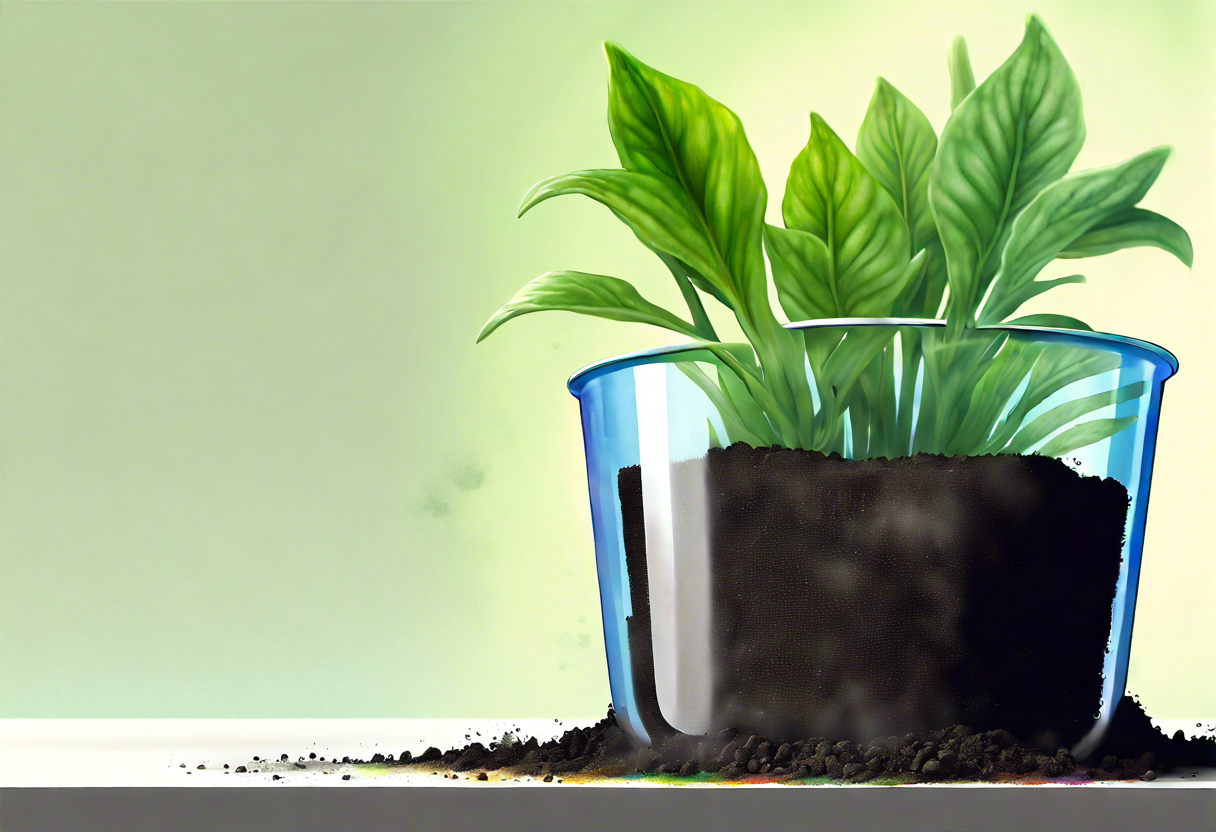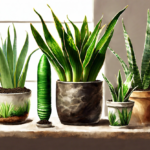Testing and Balancing Indoor Plant Soil pH: The Secret to Healthy Plants
Keeping the soil pH balanced is crucial for the health and vitality of indoor plants. As a responsible plant owner, it is essential to understand the importance of testing and maintaining the right pH level in your indoor plant’s soil.
Why Test and Balance Indoor Plant Soil pH?
The pH level of the soil directly affects the plant’s ability to absorb nutrients. When the soil pH is too high or too low, it can hinder the plant’s nutrient uptake, leading to nutrient deficiencies and poor overall growth. Different plants thrive in varying pH conditions, and ensuring that the pH falls within the optimal range for your indoor plants is key to their well-being.
1. Nutrient Availability: Soil pH plays a crucial role in nutrient availability. Some nutrients become more readily available to plants in acidic soil, while others are easily absorbed in alkaline soil. Regularly testing the soil pH allows you to make the necessary adjustments to prevent nutrient deficiencies.
2. Growth and Development: Balancing soil pH encourages healthy root development. When the pH is within the optimal range, plants can efficiently absorb water and nutrients from the soil, resulting in robust growth, vibrant foliage, and abundant blooms.
3. Disease Resistance: Imbalanced soil pH creates an environment that is favorable for certain plant diseases and pests. By maintaining the right pH level, you can prevent the onset of diseases and protect your plants from potential infestations.
How to Test Indoor Plant Soil pH
Testing indoor plant soil pH is relatively easy and can be done using a pH testing kit or pH meter specifically designed for gardening purposes. These kits are readily available at garden centers or online stores. To test the soil pH, follow the instructions provided with the kit, which usually involves taking a soil sample and adding the necessary reagents.
How to Balance Indoor Plant Soil pH
Adjusting the soil pH depends on whether it is too acidic or too alkaline. If the pH is too high (alkaline), you can lower it by incorporating organic matter, such as peat moss or compost, into the soil. These materials help to acidify the soil naturally over time.
Conversely, if the pH is too low (acidic), you can raise it by adding amendments like agricultural lime or wood ash. These materials increase the soil’s alkalinity, gradually bringing it into the desired range.
When making pH adjustments, it’s important to monitor the changes over time and retest the soil periodically to ensure the pH remains within the optimal range for your specific plants.
Remember, each plant species has its own preferred pH range, so it’s crucial to research and understand the specific requirements of your indoor plants.
By testing and balancing indoor plant soil pH, you provide your plants with the best possible growing conditions. Regular monitoring and adjustments will help your indoor plants thrive and flourish, rewarding you with a beautiful and healthy indoor garden.
Factors Affecting Indoor Plant Soil pH Levels
Maintaining the ideal soil pH level is crucial for the overall health and growth of indoor plants. Factors such as water quality, fertilizers, and plant species can significantly influence the pH levels of the soil. Understanding these factors is essential for creating an optimal environment for your indoor plants to thrive.
One of the key factors that affect soil pH levels is the quality of water used for irrigation. Water sources can have different pH levels due to the presence of minerals and other dissolved compounds. For example, water with high levels of limestone may have a higher pH, which can lead to alkaline soil conditions. On the other hand, water with high acidity can lower the pH levels, resulting in acidic soil conditions. It is essential to test the pH of your water source and, if necessary, treat it to achieve the desired pH range for your plants.
Another factor is the type and amount of fertilizers used. Fertilizers contain nutrients that are essential for plant growth. However, they can also contribute to changes in soil pH. For instance, fertilizers with high amounts of nitrogen can increase the soil’s acidity over time. Similarly, fertilizers with high levels of phosphorus can raise the pH level, leading to alkaline soil conditions. It is crucial to use fertilizers that are specifically formulated for indoor plants and monitor the pH levels regularly to avoid imbalances.
Different plant species have different preferences when it comes to soil pH levels. Some plants, such as azaleas and blueberries, require acidic soil conditions to thrive, while others, like cacti and succulents, prefer more alkaline environments. Understanding the optimal pH range for each plant species is vital for their healthy growth. Research the specific requirements of your indoor plants and adjust the soil pH accordingly to create an environment that mimics their natural habitat.
Furthermore, the composition of the potting mix or soil used can influence the pH levels. Some potting mixes are specifically formulated to be pH-neutral, while others may have a slightly acidic or alkaline nature. When selecting a potting mix, consider the pH requirements of your plants and choose a suitable mix that will help maintain the desired pH range.
Environmental factors such as temperature and humidity can indirectly impact soil pH levels. Higher temperatures can accelerate microbial activity, leading to increased acidification of the soil. Additionally, high humidity levels can slow down the breakdown of organic matter, resulting in more acidic conditions. It is crucial to monitor and regulate these environmental factors to maintain a stable soil pH level.
Several factors influence the pH levels of indoor plant soil. Water quality, fertilizers, plant species, potting mix composition, and environmental conditions all play a role in maintaining the optimal pH range. By understanding and adjusting these factors, you can provide the best possible growing environment for your indoor plants, ensuring their health and vitality. Regular soil pH testing is essential to identify any imbalances and take corrective measures promptly.
Understanding the Optimal pH Range for Different Types of Indoor Plants
Ensuring the optimal pH range for your indoor plants is crucial for their overall health and well-being. The pH level of the soil directly affects the plant’s ability to absorb nutrients and thrive. Different types of indoor plants have specific pH preferences, and understanding these preferences can help you create the ideal growing conditions for your green companions.
Most indoor plants thrive in slightly acidic to neutral soil, with a pH range between 6 and 7. However, it is essential to note that some plants have specific pH requirements outside of this range.
For example, acid-loving plants such as azaleas, camellias, and blueberries prefer a more acidic pH level ranging from 4.5 to 6. On the other hand, succulents and cacti thrive in soil with a pH level between 5.5 and 7.5.
Furthermore, certain indoor plants, such as African violets and ferns, prefer slightly more acidic soil with a pH range of 5.5 to 6.5. These plants are particularly sensitive to pH imbalances, and maintaining the proper acidity level is crucial for their growth.
Another group of indoor plants that have unique pH requirements are alkaline-loving plants. These include plants like lavender, sage, and asparagus fern. They prefer soil with a pH ranging from 7.5 to 8.5.
To determine the optimal pH range for a specific indoor plant, it is recommended to conduct a soil pH test. Soil pH test kits are readily available at garden centers or can be ordered online. The test will help you understand your soil’s current pH level, allowing you to make the necessary adjustments.
It is important to note that excessively acidic or alkaline soil can lead to nutrient deficiencies and hinder the plant’s ability to absorb vital minerals. Therefore, maintaining the appropriate pH range is essential for the plant’s overall health and growth.
Adjusting the soil pH for indoor plants can be achieved through various methods. For example, if the soil is too acidic, adding agricultural lime or dolomite can help raise the pH level. On the other hand, if the soil is too alkaline, incorporating organic matter such as compost or peat moss can help lower the pH.
Understanding the optimal pH range for different types of indoor plants is crucial for their well-being. Each type of plant has specific pH preferences, and providing the right pH conditions will promote healthy growth. Conducting regular soil pH tests and making necessary adjustments will ensure that your indoor plants thrive in their environment.
The Importance of Adjusting and Maintaining Indoor Plant Soil pH
Creating and maintaining the right soil pH for indoor plants is crucial for their overall health and growth. The pH level of the soil refers to its acidity or alkalinity, with a scale ranging from 0 to 14. A neutral pH is 7, while values below 7 indicate acidity and above 7 indicate alkalinity. Different plants have specific pH preferences, and maintaining the optimal range helps them absorb nutrients and thrive.
One of the primary reasons for adjusting and maintaining indoor plant soil pH is to ensure the availability of essential nutrients. Soil pH directly affects the solubility of nutrients in the soil. When the pH deviates from the preferred range, nutrients may become locked in the soil and inaccessible to plants. For example, if the soil is too acidic, nutrients like phosphorus, nitrogen, and potassium are less available, leading to nutrient deficiencies and stunted growth.
Another reason to adjust soil pH is to prevent toxic nutrient imbalances. When the pH is too high or too low, certain nutrients can become overly concentrated in the soil, potentially harming the plants. For instance, acidic soil can result in an excess of aluminum and manganese, which can be toxic to plants. By maintaining the appropriate pH range, you can prevent these imbalances and protect your indoor plants.
Adjusting and maintaining indoor plant soil pH also promotes healthy root development. When the pH is not within the desired range, the roots may struggle to absorb water and nutrients effectively. This can lead to root stress, reduced nutrient uptake, and overall poor plant health. By providing the right pH conditions, you create an environment where roots can thrive, ensuring better overall plant growth.
Furthermore, maintaining proper soil pH helps prevent the growth of harmful bacteria, fungi, and pests. Some microorganisms thrive in specific pH conditions, and an imbalance can encourage their proliferation. For example, acidic soil favors the growth of fungi such as Pythium and Fusarium, which can cause root rot and other diseases. By adjusting the pH to the recommended range, you can create an inhospitable environment for these detrimental organisms, reducing the risk of plant diseases.
Adjusting and maintaining indoor plant soil pH is essential for the overall health and vitality of your plants. It ensures nutrient availability, prevents toxic imbalances, supports root development, and reduces the risk of disease. By understanding the pH preferences of different indoor plants and implementing proper soil management, you can provide the optimal conditions for your plants to flourish.
Common Signs and Symptoms of Imbalanced Soil pH in Indoor Plants
Proper soil pH is crucial for the optimal growth and development of indoor plants. When the pH levels of the soil become imbalanced, it can have detrimental effects on the health and vitality of your plants. By understanding and recognizing the signs and symptoms of imbalanced soil pH, you can take timely measures to rectify the situation and ensure the well-being of your indoor garden.
One of the most common signs of imbalanced soil pH is unhealthy foliage. If your indoor plants are displaying yellowing leaves or stunted growth, it may be an indication that the soil pH is too high or too low. High soil pH, also known as alkaline soil, can lead to nutrient deficiencies as certain minerals become less available to the plants. On the other hand, low soil pH, referred to as acidic soil, can cause toxicity issues as certain elements become more soluble and can be taken up in excess by the plants.
Another telltale sign of imbalanced soil pH is the appearance of nutrient deficiencies. Different nutrients are absorbed by plant roots at varying pH levels. For example, iron deficiency is often observed in plants growing in alkaline soil, whereas zinc deficiency is more common in acidic soil. When the soil pH is not within the optimal range for a specific plant, it can hinder the absorption and utilization of essential nutrients, leading to deficiencies and subsequent negative effects on plant health.
Imbalanced soil pH can also affect the availability of certain beneficial microorganisms in the soil. Many beneficial bacteria and fungi play a crucial role in nutrient cycling and plant root health. However, extreme pH levels can disrupt their populations, reducing their ability to establish and thrive. This can further impact the overall health and vigor of your indoor plants.
Furthermore, imbalanced soil pH can make your plants more susceptible to pests and diseases. When the soil pH is not within the ideal range, plants may become weaker and more vulnerable to attacks from pests and pathogens. This is because imbalanced pH can weaken the plants’ natural defense mechanisms and compromise their ability to resist external threats.
By being aware of these common signs and symptoms of imbalanced soil pH, you can take proactive measures to address any issues promptly. Regularly testing the pH levels of your indoor plant soil and making necessary adjustments can help you maintain a healthy growing environment for your plants. Monitoring your plants for any visual cues of imbalanced soil pH can also ensure early detection and intervention, leading to thriving indoor greenery.
Conclusion
Maintaining the proper pH levels in indoor plant soil is crucial for the overall health and well-being of your plants. By testing and balancing the pH, you can ensure optimal growth, nutrient absorption, and disease resistance. Factors such as water quality, fertilizers, and the type of plant itself can all influence soil pH levels. Understanding the ideal pH range for different types of indoor plants is essential for providing them with the right growing conditions. Adjusting and maintaining the pH can be achieved through various methods, including amending the soil, using pH-adjusting additives, and selecting appropriate fertilizers. It is important to regularly monitor the pH levels and make necessary adjustments to prevent imbalances that can lead to nutrient deficiencies or toxicities. Common signs of imbalanced soil pH include stunted growth, yellowing leaves, and poor overall health. By addressing these symptoms and taking proactive steps to maintain the proper pH, you can create a favorable environment for your indoor plants to thrive and flourish.


